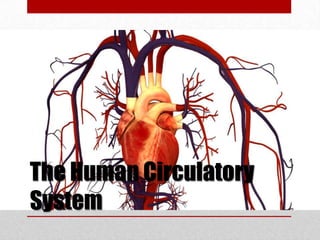
The human circulatory system
- 2. • E2.2 perform a laboratory or computer- simulated dissection of a representative animal, or use a mounted anatomical model, to • E3.3 explain the anatomy of the circulatory analyse the relationships between the system e.g., blood components, blood respiratory, circulatory, and digestive vessels, the heart) and its function in systems [PR, AI] transporting substances that are vital to health • E2.3 use medical equipment (e.g., a stethoscope, a sphygmomanometer) to • E3.4 describe some disorders related to the monitor the functional responses of the respiratory, digestive, and circulatory respiratory and circulatory systems to systems (e.g., asthma, emphysema,ulcers, external stimuli (e.g.,measure the change in colitis, cardiac arrest, arteriosclerosis) breathing rate and heart rate after exercise) [PR, AI] SBI 3U
- 3. • Functions • Circuits • Components Heart, Blood, Veins and Arteries, Capillaries • Cardiac Cycle • Heart Beats • Blood Pressure For Consideration
- 4. Closed System • blood never leaves the network of blood vessels • O2, CO2, and nutrients are diffused from blood into tissues Human Circulatory System
- 5. • Transport of oxygen and carbon dioxide • Distribution of nutrients and transport of wastes • Maintenance of body temperature • Circulation of hormones • Protection against blood loss from injury Functions
- 7. • Has 4 chambers where blood fills • Top chambers are called atria • Bottom chambers are called ventricles • Atria and ventricles are separated from each other via a septum (thick muscular wall) • Valves in the heart prevent blood from flowing the wrong way • Pumps blood through the body via a network of veins and arteries The Human Heart
- 8. • Pulmonary Circulation • Coronary Circulation • Systemic Circulation 3 Main Circuits
- 9. • Oxygen rich blood is pumped within the heart muscle Coronary Circulation
- 10. • Oxygen poor blood is pumped into the lungs • Oxygen rich blood is carried back to the heart Pulmonary Circulation
- 11. • Oxygen rich blood is carried to body tissues • Oxygen poor blood is carried back to the heart Systemic Circulation
- 15. • Made up of 4 Components 1. Plasma 2. White Blood Cells 3. Platelets 4. Red Blood Cells Blood
- 16. • Deliver oxygen to the body tissues received from lungs and remove carbon dioxide from the bodies tissues • Red only because they contain a protein chemical called hemoglobin which is bright red in color • Hemoglobin contains the element Iron, making it an excellent vehicle for transporting oxygen and carbon dioxide • The average life cycle of a red blood cell is 120 days Red Blood Cells
- 17. • Also called Leukocytes • Protect the body from disease • Will produce antibodies in the body to fight off germs and infection White Blood Cells
- 18. • Platelets are irregularly-shaped, colorless bodies that are present in blood. Their sticky surface lets them, along with other substances, form clots to stop bleeding. • The mineral calcium, vitamin K, and a protein called fibrinogen help the platelets form a clot. Platelets
- 19. • Liquid component of blood which is 90% water • contains blood proteins, glucose, vitamins, minerals, dis- solved gases, and waste products of cell metabolism. • Proteins help maintain body homeostasis Plasma
- 20. • one epithelial cell thick • exchange of oxygen and carbon dioxide takes place through the thin capillary wall. • red blood cells inside the capillary release their oxygen which passes through the wall and into the surrounding tissue. • tissue releases its waste products, like carbon dioxide, which passes through the wall and into the red blood cells. Capillaries
- 22. Cardiac Cycle
- 23. • is controlled by a nerve impulse called the Sino atrial node (SA node). • The SA node is also referred to as the natural pace maker. • . The “lub” sound is produced when the tricuspid and mitral valves open and close. • The “dub” sound occurs when the pulmonary and aortic valve open and close. Heart Beat
- 24. • http://chs.sd57.bc.ca/~jbleecker/science/bi12ppt/Bio12_2/ C13_Circulatory%20System_Newer/cardiac.swf Heart Beat
- 25. • An electrocardiogram (ECG) is a test that measures the electrical activity of the heart. • A normal resting heart rate is 70 beats per minute with a consistent and even rhythm • As you know, your heart rate can fluctuate throughout the day. • Factors affecting HR can include exercise, sleeping, emotions, drugs and. Heart Rate
- 26. • A sphygmomanometer is used to measure blood pressure. The normal average blood pressure reading is 120/80. The systolic pressure is always recorded first. Blood Pressure
- 27. High blood pressure is dangerous because: • pressure the blood places on the vessels may cause them to burst • narrowing of the artery. • build up of plaque on the arterial walls. • High blood pressure can generally be reduced by making lifestyle changes such as exercise and healthy diet High Blood Pressure
- 28. Measuring BP
- 29. Circulatory Conditions • Angina • Atherosclerosis • Arrythmias Lymphatic System Other Things to Consider
- 30. • www.innerbody.com • www.youtube.com • Nelson Biology 11 Text Resources